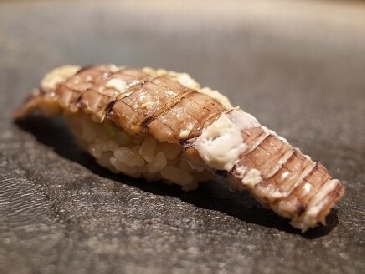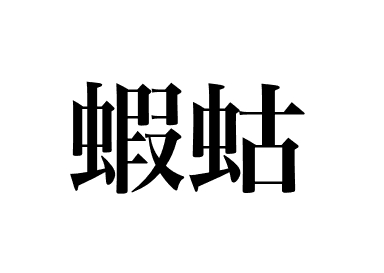Simmered


Squilla (Shako)
【Nigiri sushi: Nimono】
What is Shako?
Shako (Squilla) is distributed from the coast of Japan south of Hokkaido to Taiwan and the northern coast of China. They inhabit the intertidal zone of inner bays and sandy mud at depths of 10 to 30 meters. Although they resemble shrimps, they are completely different species, having sharp legs like the sickle of a praying mantis and compound eyes that protrude forward. Total length reaches 20 cm.
When is the Shako (Squilla) is alive, it has a gray or light brown color. It transforms when it’s boiled. It changes to a reddish-purple color like the flowers of a rhododendron (shakunage). For this reason it was known as “shakunage,” which for some reason lead to the mispronounced version of the word, “shako.”The texture of the meat after being boiled with salt is different than that of shrimp, and you can also enjoy its rich fragrance. It comes into season in late fall before molting, but shako carrying eggs, which appear from early spring to early summer, are considered the best. The roe, called Katsubushi, is a top-grade delicacy.
Sushi restaurants use female shako with eggs as a snack and male shako as sushi material. This is because the male shako has a stronger flavor and the lack of eggs allows the shako meat to blend well with the sushi rice when made into nigiri.
After nigiri is made, the shako is sometimes seasoned with Nitsume, Nikiri, or Salt, depending on the condition of the shako and the taste of the customer. After nigiri is made, the shako is sometimes seasoned with Nitsume, Nikiri, or salt, depending on the condition of the shako and the taste of the customer. Sushi chefs are also very flexible, for example, searing the shako.
In my opinion, the best time to eat shako is in early fall, when the fish is full of meat, rather than when it is in the egg-carrying stage. The sweetness of the shako-tsume is particularly noticeable, making it the tsumami of choice for connoisseurs.
Shako (Squilla) has a self-digestion enzyme that is activated when it dies, melting the body leaving only a shell, so there is nothing left to prepare for eating. So after being caught, it is boiled straight out of the net while still alive and packaged for distribution immediately.
Squilla is not valued as highly as shrimp or crab at the market, but it has a very high nutritional value. It contains minerals such as copper and manganese. It has higher vitamin A, B1, B2, B12, etc. content than shrimp and crab and also contains potassium, which prevents high blood pressure, and taurine, which controls cholesterol. It is especially rich in vitamin B12, which helps anemia, so you can expect this fish to keep your blood healthy.
Also called Mantis shrimp.
(Revision date: December 30, 2023)
Main production area
Setonaikai Ariakekai
Famous production area
Koshiba Otaru Nanao Mikawa Bay kanonji
Season
June-July

